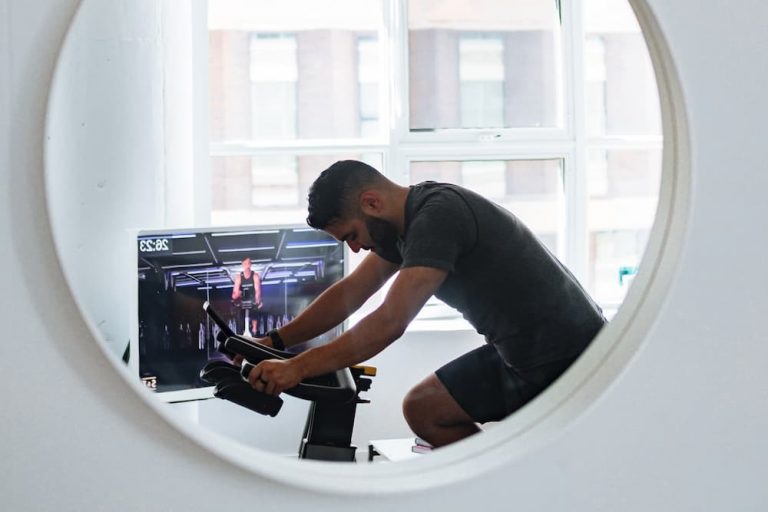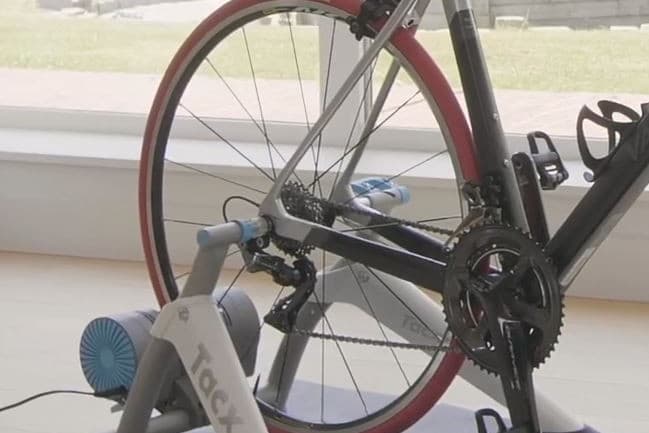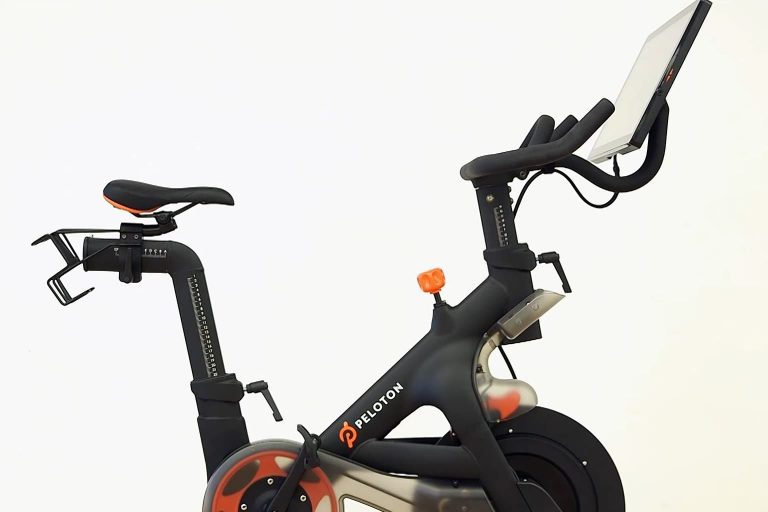Indoor Cycling Trainer Types – A Quick Guide
Cycling is a fantastic form of exercise, but what happens when your routine is disrupted by weather extremes or other unforeseen circumstances? It can be frustrating, we know. You’re eager to keep up with your fitness goals, but sometimes life just gets in the way. That’s where indoor cycling trainers come in, providing a solution that allows you to continue your workouts from the comfort of your home.
But with so many types of indoor cycling trainers available, how do you choose the right one for you?
In this comprehensive guide, we’ll explore various Indoor Cycling Trainer Types, each with its unique benefits and features. We’ll delve into stationary bike trainer stands, smart trainers, exercise bikes, and even under-desk bike trainers. We’ll also discuss the essential features to consider when choosing a trainer.
Whether you’re an athlete or a housewife, this article will equip you with the knowledge you need to make an informed decision. So, rest assured, you’ve come to the right place. Let’s embark on this journey together and find the perfect indoor cycling trainer for you.
Stationary Bike Trainer Stand

Despite our best efforts, sometimes life throws curveballs at our training routines. Even elite cyclists face challenges that limit their workout sessions, and that’s where an indoor bike trainer stand comes in!
A bike trainer is an ingenious piece of equipment that allows you to mount your own bicycle and transform it into an indoor exercise machine. This isn’t just a tool for the pros. Quite the contrary, it offers flexibility, doubles as a fitness aid, and protects your wallet all at the same time.
So, who does this marvel of modern machinery serve? Well, it’s a perfect fit for a broad range of individuals:
- Fitness enthusiasts looking to replicate gym workouts at home.
- Cyclists who find winter weather conditions to be a barrier to their training.
- Tech aficionados who love incorporating advanced features into their equipment.
- Efficiency seekers who enjoy multitasking while getting in a good workout.
- Those who adhere to “stay at home” guidelines during times like a pandemic.
If you find yourself nodding in agreement with any of these categories, then an indoor bike trainer stand could be a game-changer for you. But why exactly should you invest in one?
An indoor bike trainer stand can be an invaluable training companion right in the comfort of your home. Cyclists worldwide, from eager beginners to seasoned pros, love using trainer stands to ensure their fitness routines aren’t sidelined by poor weather or inconvenient timing. Plus, the freedom to pedal at any hour is a true boon.
However, a little extra motivation never hurts. That’s why we always advocate doing your due diligence before taking the plunge and making a purchase.
For a deeper dive, don’t miss our comprehensive post on indoor bike trainer stands. Trust me, you’ll be thanking us later. It features the crème de la crème of stands available, saving you from the hassle of narrowing down your choices.
Smart Bike Trainers
As a cycling enthusiast, I can tell you that a stationary bike trainer can be a real boon when outdoor riding isn’t an option. However, even the most die-hard cyclists among us can agree, the stationary experience can grow monotonous over time. Enter the solution: smart trainers.
Smart trainers, a specialized type of stationary bike trainer, are designed to inject a much-needed dose of outdoor fun into your indoor workout. How do they manage to do this? By cleverly integrating with fitness apps.
A smart trainer pairs with an app, allowing the app to control and adjust the resistance levels remotely. This not only offers a more engaging workout but also a more realistic road-like feel. While it’s true that smart trainers may come with a heftier price tag, I’ve found that many users, myself included, think the investment is well worth it.
What’s more, if you’re a competitive spirit and miss the thrill of racing your buddies outdoors, apps like Zwift have you covered. From the comfort of your home, you can now challenge your friends, engage in virtual races, and work up a serious sweat, even in these pandemic times. I guarantee, with a smart trainer and the right app, you won’t even miss hitting the open road.
Stationary Bike Trainer Features
Let’s take a look at the essential features of stationary bike stands.
Flywheel
The flywheel sits at the heart of your stationary bike trainer, providing a road-like feel through the generation of inertia. From my experience, the heavier the flywheel, the more authentic your indoor cycling experience will be.
However, innovation never stops in the cycling world. The latest flywheels use a different approach to simulate inertia: magnets. They create a virtual flywheel effect, which could be an exciting option depending on your budget.
Portability and Weight
Stationary bike trainers, particularly smart trainers, come in a variety of sizes. A key advantage is that they’re typically lighter and more portable than other trainers. They can often be folded up neatly and stowed away post-workout.
If you have a dedicated workout space (or as we cyclists affectionately call it, a “pain cave”), weight may not be a significant factor. However, if you’re setting up and storing your trainer after each session, steer clear of direct-drive smart trainers as they tend to be heavier.
Power and Incline
Different types of smart bike trainers offer different power levels to match the resistance you’d experience on the road. For most cyclists, a trainer offering up to 1,500W will suffice. But if you’re aiming for a more professional level of training, you might want to consider a model that can hit a power output of 2,000W.
Also, think about the incline level your preferred trainer can simulate. My advice? Don’t bite off more than you can chew. Choose a trainer that matches your fitness level to ensure an effective simulation.
Noise Level
The interaction between the trainer and the flywheel generates noise. Trust me, a noisy trainer can quickly become a nuisance, especially if you live with others. So when you’re shopping for a smart trainer, look for models that offer a balance between effective resistance and low noise levels. This way, you can maintain peace at home while still getting a killer workout.
Pros and Cons of Smart Bike Trainers
Just like any piece of fitness equipment, smart trainers have their own set of advantages and disadvantages. Before taking the leap, it’s crucial to weigh up the pros and cons to decide if a smart trainer is the right fit for your indoor cycling routine.
Pros of Using Smart Trainers
- Simulating Outdoor Cycling: The primary allure of smart trainers is their ability to mimic outdoor cycling, providing a realistic and engaging riding experience indoors.
- Bike Familiarity: One of the things I love about smart trainers is that they let you use your own bike. This ensures a genuine cycling position and a comfortable ride, just as you would experience outdoors.
- Portability: Given their compact design, smart trainers don’t take up much space, making them highly portable and easy to stow away after your session.
Cons of Using Smart Trainers
- Bike Dependency: The biggest drawback is that you need your own bike to use these trainers. If you don’t already own one, this could be a stumbling block.
- Potential High Cost: It’s also worth mentioning the cost factor. The combined expense of a bicycle and a smart trainer can be substantial, so you’ll want to consider this before making a purchase.
Related reading: Do Bike Trainers Ruin Tires?
Exercise Bikes
Exercise bikes have become increasingly popular as a preferred method for low-impact aerobic workouts. They’re particularly effective for toning and building core muscles, making them a hot pick among fitness enthusiasts seeking a streamlined workout solution.
Modern exercise bikes are more advanced than ever, boasting features like mileage counters, speed trackers, and displays for other relevant data. If you have internet connectivity, it can even keep track of your workout sessions, providing a comprehensive fitness record.
There are several reasons why an exercise bike could be a fantastic choice for you, one of which is the improvement of your aerobic fitness. Cycling and other cardio workouts not only fortify your heart, lungs, and muscles but also improve your circulation.
Spin Bike or Fitness Bike
Despite all exercise bikes sharing the common goal of a good sweat session, each brings something unique to the table. If you’re looking for a serious cardio workout, a spin bike could be an ideal choice.
There’s a plethora of reasons why spin bikes stand out from other stationary bikes. Some of these differences include the bike’s design and the intensity of workouts it can provide.
Upright Exercise Bike
An upright exercise bike offers a convenient and traditional workout option. Its design, closely resembling a conventional bike, doesn’t provide back support but does ensure a traditional riding posture to help you achieve your fitness goals.
These bikes come in a variety of models, boasting features like handlebars for better grip and monitors displaying your workout data. Some even come equipped with built-in tech to make your session more enjoyable. A standout feature is the heart-rate monitor, serving as a safety measure and a guide to regulate your exertion.
There are countless upright exercise bikes in the market, each boasting unique attributes that can aid you in your fitness journey.
Recumbent Exercise Bike
A recumbent exercise bike provides a wider, reclined workout position, ensuring maximum comfort. Featuring a comfortable seat and front-facing pedals, it allows for even weight distribution.
This style of bike is an excellent choice for individuals with back issues or other injuries, offering support with handlebars at the front and sides. The large display, often with pre-loaded training programs, adds to the bike’s allure.
However, it’s essential to consider the size of the recumbent bike due to its larger footprint compared to other models. This type of bike can be a great choice for the following reasons:
- The design is easier on the back and joints.
- It provides a full-body cardio workout.
- No need to strain your back to reach the handlebars, which allows for multitasking.
- The low-mounted, bucket-shaped seats offer improved comfort.
- They work various muscles at different angles, resulting in less strain and targeted toning.
Airdyne Bike
Airdyne bikes offer a unique cycling experience compared to other bikes. Unlike a spin bike, which uses a manually adjusted flywheel for resistance, Airdyne bikes use a large, built-in fan. The harder and faster you pedal with your arms and legs, the greater the resistance generated by the fan.
This bike is ideal for all fitness levels, providing a low-impact, seated workout. The icing on the cake is its ability to work both your upper and lower body, allowing for a comprehensive workout all in one session.
Exercise Bike Features
Flywheel
The flywheel plays a crucial role in increasing the intensity of the workout. Its impact is largely determined by its weight.
Exercise bikes with lightweight flywheels help maintain a smooth ride. The flywheel continues to spin and gradually comes to a stop when you cease pedaling. On the contrary, spin bikes feature a considerably heavier flywheel. The pedals on these bikes are connected to the flywheel, allowing them to roll with the flywheel’s inertia.
This means you’ll have to manually stop it. To do so, slowly reduce the pace until it loses momentum. Additionally, due to its size, you’ll need to put in extra effort to keep it operational. As a result, working out with this type of equipment is more challenging and effective.
Seat Position
Most exercise bikes come with standard commuter seats. However, some spin bikes offer a racing-like position. The handlebars on these bikes are constructed at an angle, causing you to lean forward. This posture puts greater stress on the body, leading to a more intense workout.
Spin bikes, in general, offer a variety of seating options. This allows you to customize your workout experience based on your comfort and fitness goals.
Intensity
As mentioned before, intensity is inextricably linked to the flywheel aspect. Flywheels, as we know, are responsible for the rigorous workouts. Riding a spin bike requires more effort from the rider, placing more stress on the body’s joints compared to a regular exercise bike.
Spin bikes also feature adjustable resistance levels, which is beneficial as it allows you to regulate the intensity level according to your capacity. If you’re looking for a more challenging workout, spin bikes are a great choice.
Other types of exercise bikes can also be considered based on your workout preferences. These bikes are designed for people who prefer a less strenuous workout. Ultimately, your choice depends on the reason you’re purchasing an exercise bike.
Cost
Spin bikes, despite being unique, come with additional features like a monitor display, adding to their cost. They are also quite durable, requiring less maintenance compared to other bikes, which is another factor contributing to their higher price.
The price of other exercise bikes is determined by the features they offer. As they’re primarily designed for light to moderate workouts, adding extra features can enhance the enjoyment and effectiveness of your sessions.
Before committing to a spin bike, you can always read more about their benefits and considerations to ensure you’re making an informed decision.
Pros and Cons of Exercise Bikes
Indeed, like any other piece of exercise equipment, exercise bikes come with their own set of pros and cons. Here’s a more detailed look at some of the advantages and disadvantages of using an exercise bike:
Advantages of Exercise Bikes
- Full-body Workout: Depending on the type of exercise bike, you can get a full-body workout. Bikes such as dual-action stationary bikes engage your arms as well as your legs.
- Cardiovascular Improvement: Regular use of an exercise bike improves heart health and decreases the risk of cardiovascular disease.
- Low Impact: Exercise bikes provide a low-impact workout that’s easier on the joints compared to other cardio exercises like running, making it ideal for people with joint issues or injuries.
- Calorie Burning: Depending on the intensity of the workout, you can burn a significant number of calories, which aids in weight loss.
- Safety: It’s safer to cycle on an exercise bike than outdoors, as it removes the risk of collisions or accidents.
- Convenience: Regardless of the weather or time of day, you can use an exercise bike in the comfort of your own home.
Disadvantages of Exercise Bikes
- Muscle Fatigue: Prolonged and intense cycling sessions can lead to muscle fatigue, especially if proper form is not maintained.
- Limited Upper Body Engagement: Traditional exercise bikes don’t offer much of an upper-body workout, making them less effective than other types of exercise for full-body conditioning.
- Balance: Falling off the exercise bike can happen if it isn’t properly balanced or if the user is not correctly positioned.
- Monotony: Some people might find cycling on an exercise bike to be monotonous compared to outdoor cycling, which provides changing scenery and terrain.
- Cost: High-quality exercise bikes can be costly, although they are an investment in your health and fitness.
Under Desk Bike Trainer
In today’s hectic world, balancing work with health can be a challenge. We often find ourselves glued to our desks with little to no time for a gym session. And by the end of the day, we’re too exhausted for a home workout.
Enter the under-desk bike trainer. This clever piece of exercise equipment was designed to address the issue of sedentary work life, allowing you to sneak in a workout without interrupting your work routine.
An under-desk bike trainer not only keeps you active throughout the day but also helps burn calories, much like other trainer bikes. Though this requires longer pedaling sessions, it’s a clear case of “slow and steady wins the race”!
The primary goal of these bikes is to substitute light activity for extended periods of sitting. A recent study from Clemson University even found that they can boost happiness, motivation, and work engagement without compromising productivity.
Pros and Cons of Under Desk Bike Trainers
Advantages of Using Under-Desk Bike Trainers
- Improves Posture: Regular use can lead to improved posture, reducing the risk of back and neck pain often associated with prolonged sitting.
- Low-Impact Exercise: It provides a low-impact workout, making it a great option for those wanting to reduce the strain on their joints.
- Enhanced Focus: Many users report enhanced focus and productivity throughout the day when incorporating an under-desk bike into their work routine.
Disadvantages of Using Under-Desk Bike Trainers
- Comfort: If not set up properly, using an under-desk bike can result in an uncomfortable sitting position, which could be a distraction while working.
Ultimately, an under-desk bike trainer can be a convenient and effective way to squeeze in some exercise during the workday. However, it’s important to set it up correctly to ensure comfort and efficiency.
Related reading: Best Indoor Cycling Accessories
Conclusion
In the realm of indoor cycling, the diversity of trainer types is truly remarkable. Each indoor cycling trainer type brings its unique set of advantages, catering to different needs and preferences. Whether you looking for a trainer for a fitness enthusiast seeking to replicate gym workouts at home, a tech aficionado who loves incorporating advanced features into their equipment, or a busy professional looking for a way to stay active during the workday, there’s an indoor cycling trainer out there for you.
Stationary bike trainer stands offer flexibility and convenience, transforming your bicycle into an indoor exercise machine. Smart trainers, on the other hand, inject a dose of outdoor fun into your indoor workout by integrating with fitness apps for a more engaging and realistic road-like feel. Exercise bikes, including spin bikes, upright bikes, and recumbent bikes, provide low-impact aerobic workouts, while under-desk bike trainers allow you to sneak in a workout without interrupting your work routine.
Indoor trainers are a fantastic way to maintain and improve your fitness levels from the comfort of your home. They offer a weather-independent, convenient, and effective solution for staying active and achieving your fitness goals. So, don’t wait any longer. Dive into the world of indoor cycling trainer types and find the perfect fit for your needs. Spin and let others spin!






